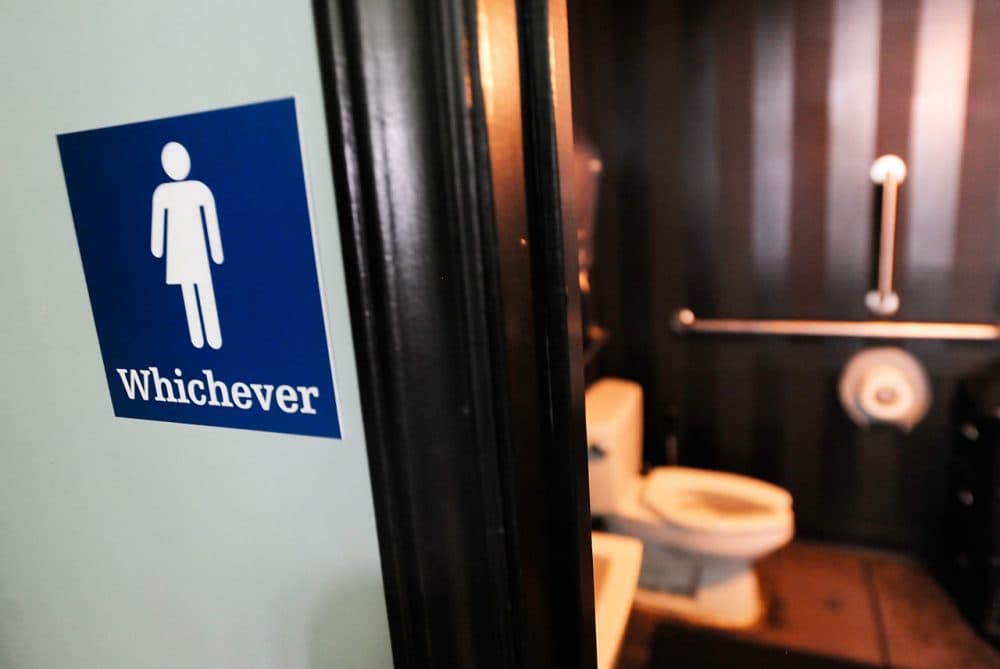Advertisement
Why Aren't Public Bathrooms More Private?
Resume
North Carolina's adoption of a so-called "bathroom bill," or House Bill 2, spurred a national conversation about the use of public bathrooms in the United States. Defenders of the law, which requires people to use public restrooms that correspond with the sex indicated on their birth certificates, say the law protects individuals in one of the most private public spaces, while LGBT advocates say the bill is misguided and harmful.
Others wonder if there may be a third solution, one that focuses on the design of public bathrooms to make them more private. Here & Now's Jeremy Hobson speaks with designer Richard Whitehall and professor of sociology Harvey Molotch about the modern American bathroom and how it should improve.
Interview Highlights: Richard Whitehall and Harvey Molotch
Would design help with dealing with the nation’s restroom issue right now?
Harvey Molotch: “I think design would, because any kind of serious attention and open consideration on how to do things better would inevitably, I think, have a positive consequence and make everybody’s life better than it is.”
Do you agree and what would you do differently?
Richard Whitehall: “I think it really starts out with signage. When you think about the way signage exists right now, it’s either an icon of a women or a man so that kind of gender bias is based into even the way we identify the bathrooms, and I think it could be something that is more focused around what people actually need to do in the bathroom. So, is it about washing your hands? Is it about standing up using a urinal or is it about sitting down, and I think those are really things that are more to do with sex and biology rather than gender.”
What about the issue of a urinal in general, isn’t that relatively gender-specific?
Whitehall: “Yeah, I think that’s actually one of the hardest issues to solve. It is something that is very gendered, but if you look at different countries, like in the U.K. and Amsterdam, they’re actually – urinals are exposed and in public spaces and it seems like people are getting more comfortable with that issue, but I think it’s one of the things that’s pretty hard to overcome with a physical design.”
Molotch: “Yeah, we had the tradition of France and Paris, where the pissoir was right on the street and it happened in a peaceful way and didn’t create a great problem. The urinal is a wonderful appliance and it creates enormous efficiencies in use, compared to having everyone go to a toilet, and now they’re water-free. So it’s something we don’t want to lose as we try to make this transition.”
If you go gender-neutral in bathrooms, how do you get past the awkwardness of having a man and a woman in adjacent stalls?
Molotch: “Well, one of the things is to have better stalls. The U.S. is exceptional in the openness of our stalls. It’s very easy for sound, for odor and for seeing and I think that creates great tension in this public space.”
Why the gaps beneath the bathroom stall doors?
Molotch: “My interpretation is because of the great anxiety that people could be doing naughty things in there, sex and drugs primarily, and every society has to deal with these things. How do you give people privacy and at the same time maintain the degree of surveillance that you feel you must have.”
How much would some of these changes cost?
Molotch: “I think the first thing to do is talk about it, because toilets and the functions that go around them are taboo subjects. If you can’t get past the taboo, you can’t move to an improvement and that’s what needs to be done. To discuss these things so that we can then decide that, yes, we would rather spend the money, and in new construction it isn’t necessarily any more money at all, there’s probably ways in which you could save money.
Right now, for example, having separate men’s and women’s rooms, so strictly separated, is extremely inefficient because there’s often extra spare space for one gender or another, especially as a public space changes between a facility mostly men are using and mostly women are using. A flower shop over, say, a boxing match. It’s expensive to maintain this mass inefficiency.”
Guests
- Richard Whitehall, managing partner for Smart Design, a design and consulting firm. He tweets @whitehall.
- Harvey Molotch, professor of sociology at New York University and co-editor of the book "Toilet: Public Restrooms and the Politics of Sharing."
This segment aired on May 12, 2016.